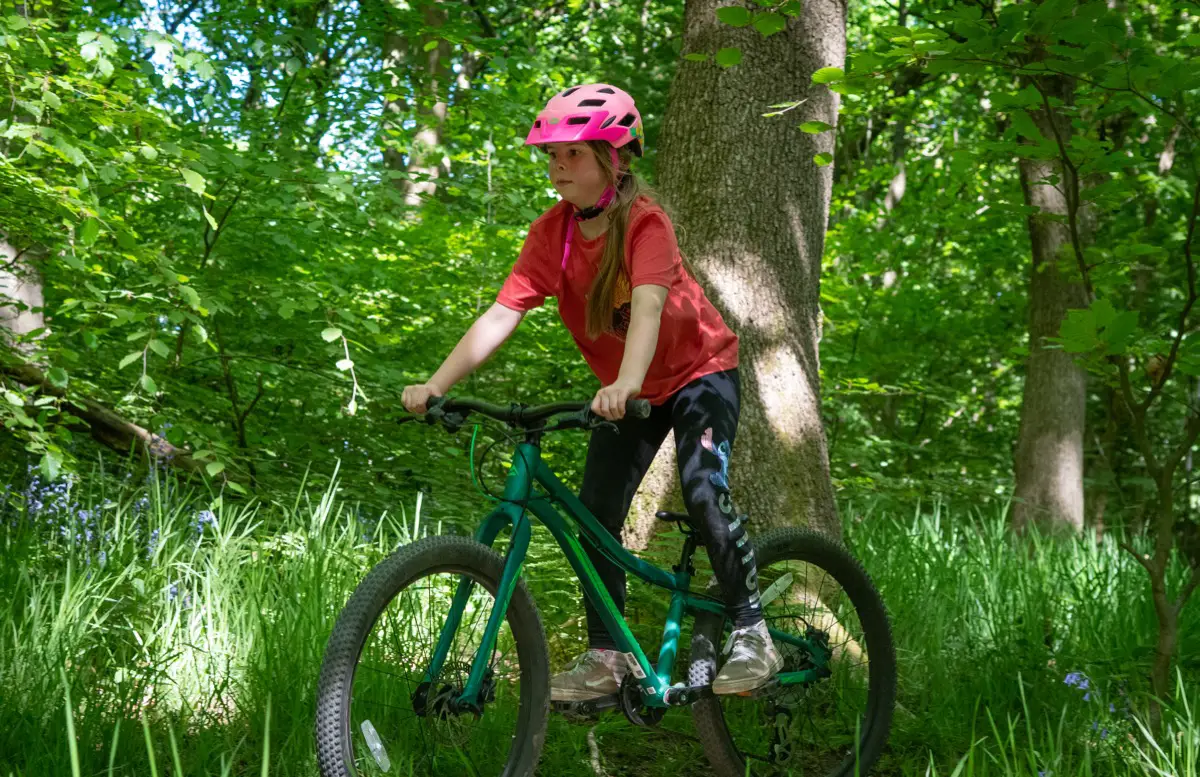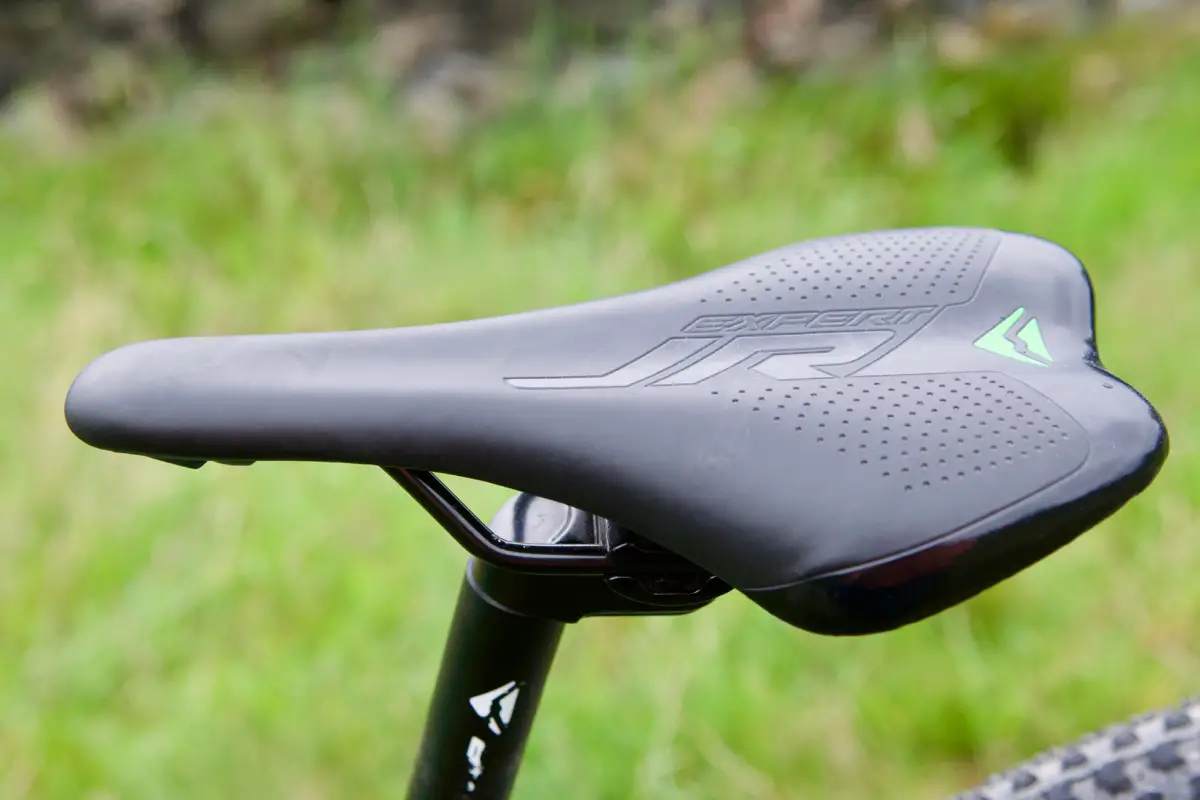Eliza Marsh swings a leg over the Merida Matts J24+ little-hitter from Merida
It’d be easy to sweep an abstracted eye over photos of the Merida Matts J24+ and assume it’s a much larger machine, as might befit (for example) an over-tall portly writer in the golden years of his life. But no, gentle reader! This here bi-cycle purports to be a rootin’ tootin’ beast of a bike for the more diminutive rider – those that tradition and protocol dictates that we refer to as ‘children’ (at least in public).

The Matts J24+ leads, intriguingly, with a question. Who or what is/was Matts? A designer? A rider? Something to do somersaults on? SomeONE to do somersaults on? History fails to record, sadly – and frankly I can’t be arsed to find out – but we can surmise a couple of details from the surname J24+. J presumably stands for ‘junior’; 24 will be the wheel size in inches, and then there’s the ever appealing ‘plus’. For lo! The Merida Matts has been generously endowed with more substantial rubber than that more usually found on kiddy fare, and this is where the fun begins.

Kit and Caboodle
Before we delve into the Wonderful World Of Plussitude, let’s cast an eye (more interested this time, please) over the rest of the bike. First of all, there’s an 11.5inch aluminium frame. Chunky looking welds; huge amounts of standover, and a very natty-looking straight bladed alloy fork. There’s an 8 speed Sunrise cassette, over which a chain is lovingly hoisted by a Shimano RD-M310 mech controlled by a single Shimano Altus trigger. At the front is a single chainring on 140mm cranks. There are wide (620mm) bars, and a short (60mm) stem. And there are Tektro hydraulic disc brakes. Oh yeah. There’s also a kickstand in the box, which we completely ignored. I’m sure it’s very nice.
The head angle is 68 degrees, seat angle is 72 degrees, and the reach is 335mm. Those look like pretty conservative figures compared to grownup machinery, but honestly, that’s hugely progressive compared to other kids’ bikes, some of which have head angles in the early seventies, literally and figuratively. Honestly, compared to this chopper, they look like they’ve already been ridden at speed into a wall as they leave the shop.
Merida branded rims, lashed onto no-name hubs seem sturdy enough for the job, but the wheels look enormous, for a kids bike – which is mostly due to the tyres. Loudly emblazoned with ‘CST – ALL TERRAINS’, they’re (superfluous ’S’ aside) pretty neat looking. 2.4in tyres on a 24 in makes them look pretty huge, and they lend a nicely purposeful stance to the whole bike, even if the tread definitely falls more into ‘fast rolling XC hardpack’ than ‘mudfest gnarschralp’ terrain(s).
The Ride
Slinging a leg over the Merida Matts, protoshredder Eliza (8) felt initially confused, she tells me – a sensation which can be translated to you or I as ‘stable’, compared to the twitchy handling of her previous bike. Wide bars, short stem, slack head angle. All of these things can, perhaps conspire to disconcert the junior biker more used to conventional bikes, with head angles steeper than the average jellybaby sugar rush, handlebars narrower than your second-favourite Disney princess’ waistline, and forks heavier than your third-favourite dinosaur. But kids are nothing if not adaptable – and although Eliza was initially disconcerted with the geometry, she soon came to appreciate its benefits. Suspension forks weighing as much as the moon aren’t really a benefit compared to a properly set up, rigid fork, with a half-way decent wheel and a plump tyre attached. She soon found she could roll up and over everything she could on her old bike, but rather faster.

Happily, those Tektro brakes (adjusted to fit her hands) performed superbly throughout the test, once they were bedded in. On her first ride, I did manage to congratulate Eliza on some rather creative line choices before she told me that her brakes weren’t slowing her down properly. Small people and dry days aren’t necessarily the best conditions for braking in the pads it seems – I suggest smearing the rotors with mud to assist the process – we had no further problems after this, and Eliza has gone on record to enthuse about how great it is to be able to stop so quickly.

Picking up speed also met with approval – the shifters have quite a long throw (which isn’t ideal) – but the action is light – in marked opposition to twist-grip shifters, which in our experience seem to offer exactly the opposite problem – and at least you don’t need two hands to shift with these, just a pronounced wrist movement, if you’ve got small hands. In any case, as Eliza seems to find a gear she’s comfortable with, and stick to it, even this minor niggle faded into insignificance as soon as she got going.
Longer distances (of several miles) were possible, thanks to the comfortable saddle, and more technical sections were definitely helped by the low standover. Saddle dropping is now apparently a necessity whenever the trail points even speculatively downwards. For my part – and this is an observation of a very great many kids’ bikes, not just this one – it seems difficult to get the saddle the right height to pedal efficiently and for Eliza to be able to put her foot down when in the saddle. This appears to be common to all of the bikes she’s ridden – maybe it’s just her – but she’s getting to be a dab hand at scooting off the front of the saddle when she stops.
Those wonderful, capacious tyres performed pretty much as expected. They were very comfortable, and huge gobs of extra traction could be gleaned by lowering the tyre pressure more than I’d usually be comfortable with – Eliza could eventually grind up quite a lot of steepness that overfeed lesser machines – but these were definitely more of a dry-weather tyre. To be fair, when the weather became somewhat more inclement, Eliza was usually happy to stick to wider paths and tracks but slithery singletrack would require some sturdier rubber.
For all its many great qualities, the bike is everso slightly porky at a smidge over 10.5kg. There are a couple of possible reasons for this – the square taper BB/crankset might be one, and the wheels and (especially) tyres might be another – but it’s a vast improvement over many other bikes aimed at the same market, and switching out the tyres has the potential to save weight easily. In any case, Eliza felt it plenty light enough for long excursions to Gisburn Forest, our local woods or long-distance towpath trips. Although there are only 8 gears, the range seems to be sufficient for her to get up most things. And for the stuff that she can’t get up? Well, that’s what dads are for.
Three things Eliza loved
- Loads of confidence and comfy
- Brilliant brakes (after they’d bedded in)
- Amazing colour
Things she felt could be improved
- The tyres were a bit slippery in the wet
- Why does it come with a kickstand?
- It was a bit strange to steer to start with, but it felt lots better quickly
Merida Matts J24+ Overall
All bikes are compromises – kids’ mountain bikes especially so. We need them to fit, to be able to roll at least some of the stuff that mums and dads do, be light enough to climb with small legs, sturdy enough to descend with *ahem* spirited line choices, and comfortable enough to spend a while in the saddle. The Merida Matts J24 comes pretty close to hitting the Platonic ideal though. It’s got great geometry, comfort, a confidence inspiring position, hydraulic disk brakes and it manages to look badass. As Eliza gets more confident, and wants to go further afield, I might investigate a lighter drivetrain, and possibly a fork, but for now, this is her perfect ride. This, then, is the ultimate endorsement: Eliza is distraught at the possibility that it has to go back – which pretty much says it all.

Merida Matts J24+ Specification
- Frame: Matts J24+ aluminium
- Fork: Matts J24+ aluminium
- Wheels: Merida J24+
- Tyres: CST Jet C1820
- Shifters: Altus
- Rear Mech: RD-M310
- Cassette: Sunrace CSM668
- Chainset: Merida 140mm
- Brakes: Tektro HD-M275
- Bars: Merida Expert JR 620mm
- Stem: Merida Expert CC 60mm
- Saddle: Merida Expert JR
- Grips: Merida Expert JR
- Seatpost: Merida Expert JR
- Size Tested: 11.5in (one size)
- Weight: 10.57kg
























Here you go:
Merida Aluminium TIG-welding Technology System
‘MATTS’stands for Merida Aluminium TIG-welding Technology System – a fancy way of drawing attention to the fact that Merida has its own production facilities and, unlike the vast majority of bike manufacturers, makes all its frames in-house.
If it’s hard for a kid to get both a good pedaling position and get their feet on the ground, the culprit is overlong cranks combined with an overly high bottombracket.
Unfortunate there is not much you can do about that on a rigid 24” bike. On bigger bikes you can switch to to a smaller rear wheel or eccentric bushing on a full suspension bike (I have done both on the bike my girls ride)
Fitting a dropper will help.
tjaard – too short cranks can also be the problem (as in this instance, I suspect). The other possibility which will definitely help on a rigid bike is to fit lower profile pedals. The issue with BB seems largely due to the design compromise generated by the need for a bike that will last a reasonable time for people who grow.
Always great to see decent bike options to cater to the huge spectrum of mini riders, but I’m not sure this bike fits the shredder moniker.
A kickstand! Brilliant.
So why does it come with a kickstand? = So your child’s bike does not end up with huge scratches on the frame/forks and grips that have the ends torn because they find it difficult/or forget to carefully lean it against walls/trees etc when they get off.
Fitted them to my children’s bikes and no more issues at all – very Euro by the way
How tall is our gnarly tester (Eliza) may I ask? Looking for a new bike for my daughter who just turned 7 and is 120cm. Cheers!